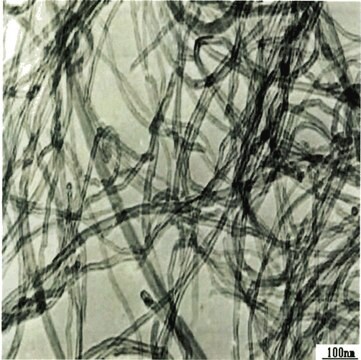698849
Carbon nanotube, multi-walled
>98% carbon basis, O.D. × L 6-13 nm × 2.5-20 μm
Sinonimo/i:
MWCNT, MWNT, Multiwall carbon nanotube
About This Item
Prodotti consigliati
Livello qualitativo
Saggio
>98% carbon basis
Forma fisica
powder
Composizione
carbon, >98% (total metals impurities)
D.E. × lungh.
6-13 nm × 2.5-20 μm
Misura
10 μm , average length, TEM
12 nm , average diameter, HRTEM
Area superficiale
~220 m2/g , SSA
Punto di fusione
3652-3697 °C (lit.)
Densità
~2.1 g/mL at 25 °C (lit.)
Cerchi prodotti simili? Visita Guida al confronto tra prodotti
Categorie correlate
Descrizione generale
Applicazioni
Stato fisico
Nota sulla preparazione
Codice della classe di stoccaggio
11 - Combustible Solids
Classe di pericolosità dell'acqua (WGK)
WGK 3
Punto d’infiammabilità (°F)
Not applicable
Punto d’infiammabilità (°C)
Not applicable
Dispositivi di protezione individuale
dust mask type N95 (US), Eyeshields, Gloves
Scegli una delle versioni più recenti:
Possiedi già questo prodotto?
I documenti relativi ai prodotti acquistati recentemente sono disponibili nell’Archivio dei documenti.
I clienti hanno visto anche
Articoli
Carbon nanotubes are materials that possess remarkable properties and offer extraordinary possibilities.
Carbon nanotubes (CNTs) have received much attention since their discovery in 1991 by Sumio lijima1 due to their excellent mechanical, electrical, and optical properties.
A nanocomposite is typically defined as a mixture between a host material (e.g., polymer matrix) and nanofillers with at least one dimension of less than 100 nm.
Graphene is a one-atomic-layer thick two-dimensional material made of carbon atoms arranged in a honeycomb structure. Its fascinating electrical, optical, and mechanical properties ignited enormous interdisciplinary interest from the physics, chemistry, and materials science fields.
Il team dei nostri ricercatori vanta grande esperienza in tutte le aree della ricerca quali Life Science, scienza dei materiali, sintesi chimica, cromatografia, discipline analitiche, ecc..
Contatta l'Assistenza Tecnica.




